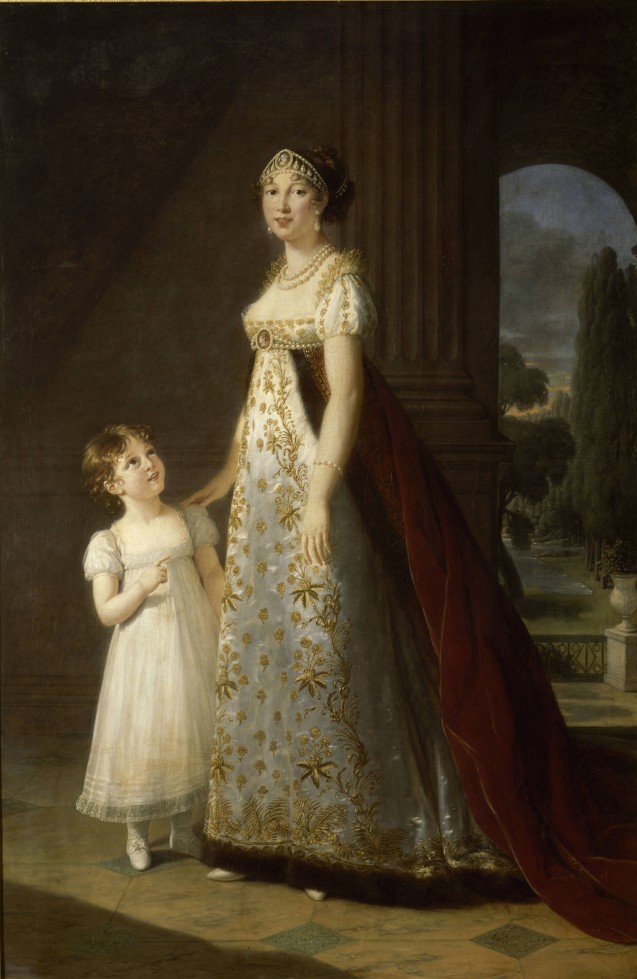This portrait, painted in 1807, marks the meeting of two exceptional women: Elisabeth Louise Vigée Le Brun, survivor of the Ancien Regime, and Caroline Bonaparte, sister of Emperor Napoleon I, a new ruler in an invented land.
Vigée Le Brun was, in effect, an escapee of the Revolution. Already a well-known portraitist from her early teens and indeed self-employed by the age of fifteen, she received increasingly prestigious commissions, until in 1778 she became Marie-Antoinette’s official portraitist, aged twenty-three. Five years later, with the support of her patron and under the order of Louis XVI, she entered the Académie royale de peinture et de sculpture; the event caused quite a debate within the institution about the admission of female artists (the same year, 1783, the number of female students would be limited to four). Not yet thirty years old, her reputation and fame had won over Paris. However, with the events of 1789, as the protégée of the royal couple she became a prime target; she fled France in October 1789 finding refuge first in Italy, and, later, in the Austrian and Russian courts. Her exile ended in 1800 when she returned to France, although she did not return to Paris until 1805. Here, her reputation allowed her to continue painting figures of both the old – and the new – French aristocracy.
Caroline Bonaparte was one of the dominant figures of this new aristocracy. The youngest sister of the Emperor, she was ambitious, and her relationship with Napoleon was often stormy. Soon after the proclamation of the Empire on 18 May 1804, she was crowned Altesse Impériale (imperial highness), and she and her husband, Joachim Murat, were given the Grand-Duché of Berg two years later. Deeming this title and territory not sufficiently honourable, Caroline actively asserted her position both at the Palais de l’Élysée (her residence from 1805) and at the Court.
Caroline and Elisabeth did not however meet by chance in 1807. When Napoleon commissioned this portrait in 1806, he not only wished to please Caroline but he also want to reinforce the legitimacy of his family politically speaking by choosing Marie Antoinette’s favourite portraitist to paint his sister. Via this portrait, Vigée Le Brun was returning to the series of royal portraits she had produced during the reign of Louis XVI, such as this portrait of Marie Antoinette which Marie sent to her mother, Marie-Thérèse. The artist had stopped making such great static compositions, preferring more intimate close-up portraits. Caroline’s portrait should be seen then in the context of official representations of power.
The young Grand Duchess Caroline is represented life-size, in the centre of the painting, and she exudes an undeniable solemnity in her posture, her jewellery and the opulence of satin embroidered with gold and the purple velvet of her dress. On the other hand, her discreet but open smile and her look directed towards the viewer slightly soften this formality. However, it is the second figure, Marie Letitzia, which really brings warmth to this official portrait. The presence of Caroline’s eldest daughter, then aged four, adds a touch of spontaneity, gaiety even cheekiness to this painting. Indeed the child embodies the only movement present in a composition whose classicist decor is secondary: she turns toward her mother as if about to ask a question, with the same indefinable smile on her face as the latter. The physical resemblance suggests that they have the same character: Marie Letitzia is a rejuvenated and purer version of Caroline, almost like an Italian putto. Elisabeth Louise Vigée Le Brun was well-known for her paintings of young children, and the presence of the child infuses her composition with a charm rarely found in such official portraits.
Caroline was used to posing for official portraits (another renowned painter, Gerard Baron, painted her in a similar full-length composition the same year). This series of official portraits of Caroline – from different periods and by different artists – reveals a common trait: she was often portrayed as a caring mother, as in this sketch by Gérard from 1801. This maternal posture even becomes central in the famous family portrait of 1810 by the same artist. In this way, little Marie-Letitzia is almost an icon of the era: throughout these paintings she represents a reassuring aspect of the Bonaparte family as in this portrait painted a year before Vigée Le Brun’s double portrait.
This symbolism of the family was not there merely to show the Bonaparte clan in an endearing light. The use of the child and the family sphere also reinforces the position of Napoleon as head of the family. Since his accession to the throne, Napoleon I had been searching for a legitimate heir, and at the time of this painting he had not yet achieved that goal: these family portraits prefigure the sustainability of the Bonaparte line.
This commission however left Vigée Le Brun with an unpleasant memory. As a result, the great portraitist of the Bourbons would make no more portraits for the Bonapartes.
Marie de Bruchard, November 2015


